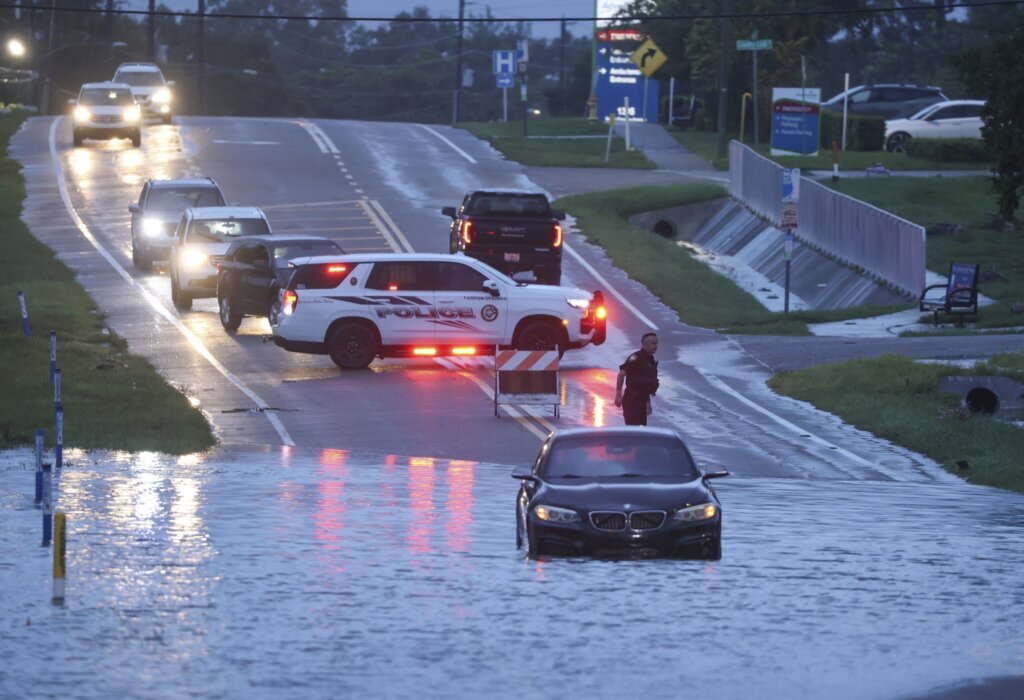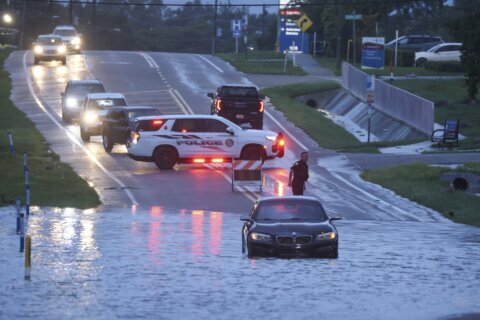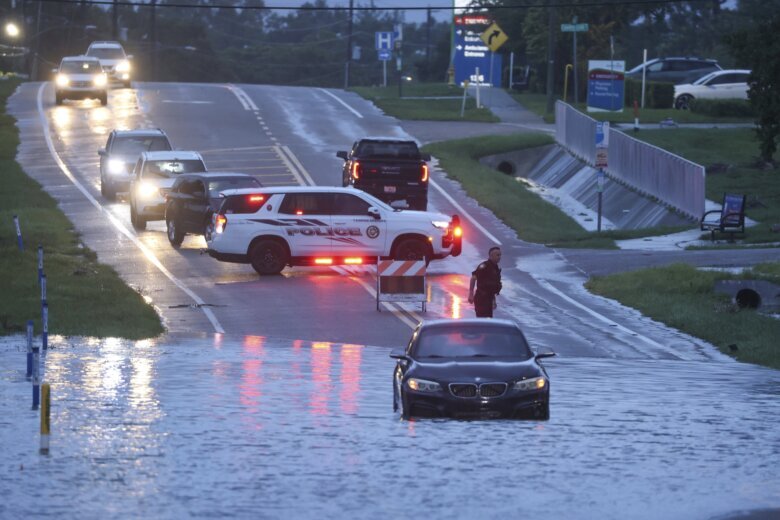Slow-moving Tropical Storm Debby bringing torrential rains and flooding to southeastern US

Tropical Storm Debby moved menacingly into some of America’s most historic Southern cities and was expected to bring prolonged downpours and flooding throughout the day Tuesday after slamming into Florida and prompting the rescue of hundreds from flooded homes.

SAVANNAH, Ga. (AP) — Tropical Storm Debby has moved menacingly into some of America’s most historic Southern cities, bringing prolonged downpours and flooding Tuesday after slamming into Florida and prompting the rescue of hundreds from flooded homes.
Record-setting rain from the storm that killed at least five people in Florida and Georgia was causing flash flooding, with up to 25 inches (64 centimeters) possible in some areas, the National Hurricane Center said in its latest advisory Tuesday morning.
“Hunker down,” Van Johnson, the mayor of Savannah, Georgia, told residents in a social media livestream Monday night. “Expect that it will be a rough day” on Tuesday, he said.
The storm’s center was just southwest of Savannah early Tuesday with maximum sustained winds near 45 mph (75 kph) and it was moving northeast at less than 6 mph (10 kph).
“Tropical cyclones always produce heavy rain, but normally as they’re moving, you know, it doesn’t accumulate that much in one place,” Richard Pasch of the National Hurricane Center said Tuesday morning. “But when they move very slowly, that’s the worst situation.”
Tropical cyclones derive their energy from warm water, so Debby has weakened over land, but part of the circulation was interacting with water over the Atlantic, Pasch said. The storm’s center is expected to move out over the water off the Georgia and South Carolina coast, then move back inland, so it could restrengthen Wednesday before it moves inland Thursday over South Carolina, he said.
More than 6 inches (15 centimeters) of rain had fallen through Monday at Savannah’s airport, and showed no signs of stopping Tuesday, the National Weather Service reported. That’s already a month’s worth of rain in a single day: In all of August 2023, the city got 5.56 inches (14.1 centimeters) of rain.
Flash flood warnings were issued in Savannah and Charleston, South Carolina, among other areas of coastal Georgia and South Carolina. Both Savannah and Charleston announced overnight curfews as the rains picked up. Charleston County Interim Emergency Director Ben Webster called Debby a “historic and potentially unprecedented event” three times in a 90-second briefing Monday.
Charleston authorities said police were barricading all eight roads leading into the 350-year-old city built on a marshy peninsula, letting only essential workers and emergency personnel in and urging all non-residents to leave Monday night.
“We need people to make their way out. This is not something you can stay at the bar until 10:45. We need you to take this seriously,” Charleston Mayor William Cogswell said.
Charleston also opened parking garages so residents could park their cars above floodwaters and updated an online mapping system to show which roads are closed due to flooding.
A tornado touched down in Edisto Beach, South Carolina, Monday night, damaging homes and blowing down trees and power lines, the Colleton County Sheriff’s Office said on social media. No injuries were immediately reported there officials said.
The weather service continued issuing tornado warnings well into Monday night for parts of the state including Hilton Head Island.
At the edge of Hilton Head Island, musician Nick Poulin wasn’t overly concerned about Debby since his equipment was inside and he made sure that his car wasn’t parked under trees so it won’t be hit by falling branches.
“I’m born and raised here, so we’ve had plenty of storms,” he said. “It’s usually not as bad as people hype it up to be.”
Debby made landfall along the Gulf Coast of Florida early Monday as a Category 1 hurricane. Weakening winds made it a tropical storm again, but its slow forward movement and the the ocean water it picked up caused catastrophic in places. About 500 people were rescued Monday from flooded homes in Sarasota, Florida, a beach city popular with tourists, the Sarasota Police Department announced. Just north of Sarasota, Manatee County officials said 186 people were rescued.
“Essentially we’ve had twice the amount of the rain that was predicted for us to have,” Sarasota County Fire Chief David Rathbun said on social media.
Gov. Ron DeSantis warned that Florida’s threat is far from over as waterways north of the state line fill up and flow south.
“It is a very saturating, wet storm,” DeSantis said. “When they crest and the water that’s going to come down from Georgia, it’s just something that we’re going to be on alert for not just throughout today, but for the next week.”
Five people had died due to the storm as of Monday night, including a tractor trailer driver who lost control on Interstate 75 in the Tampa area, flipping over a concrete wall and dangling over the edge before the cab dropped into the water below. Sheriff’s office divers located the body of the 64-year-old man from Mississippi in the cab, 40 feet (12 meters) below the surface, according to the Florida Highway Patrol.
A 13-year-old boy died when a tree fell on a mobile home southwest of Gainesville, Florida, and in Dixie County, near where Debby made landfall, a 38-year-old woman and a 12-year-old boy died in a car crash on wet roads. In south Georgia, a 19-year-old man died when a large tree fell onto a porch at a home in Moultrie, The Atlanta Journal-Constitution reported.
More than 140,000 customers remained without power in Florida and Georgia on Tuesday morning, down from a peak of more than 350,000, according to PowerOutage.us and Georgia Electric Membership Corp. Nearly 12,000 more were without power in South Carolina early Tuesday.
More than 1,600 flights were also canceled nationwide on Monday and more than 550 flights were canceled early Tuesday, many of them to and from Florida airports, according to FlightAware.com.
President Joe Biden approved emergency declarations making federal disaster assistance available to Florida, Georgia and South Carolina.
Vice President Kamala Harris postponed a campaign stop scheduled for Thursday in Savannah.
North Carolina is also under a state of emergency after Gov. Roy Cooper declared it in an executive order signed Monday. Several areas along the state’s coastline are prone to flooding, such as Wilmington and the Outer Banks, according to the North Carolina Floodplain Mapping Program.
North Carolina and South Carolina have dealt with three catastrophic floods from tropical systems in the past nine years, all causing more than $1 billion in damage.
In 2015, rainfall fed by moisture as Hurricane Joaquin passed well offshore caused massive flooding. In 2016, flooding from Hurricane Matthew caused 24 deaths in the two states and rivers set record crests. Those records were broken in 2018 with Hurricane Florence, which set rainfall records in both Carolinas, flooded many of the same places and was responsible for 42 deaths in North Carolina and nine in South Carolina.
___
Collins reported from Columbia, South Carolina. Associated Press contributors include Jeff Martin in Atlanta, Freida Frisaro in Fort Lauderdale, Florida; Kate Payne in Tallahassee, Florida; Michael Schneider in Orlando, Florida; Darlene Superville and Will Weissert in Washington, and Lisa Baumann in Bellingham, Washington.

